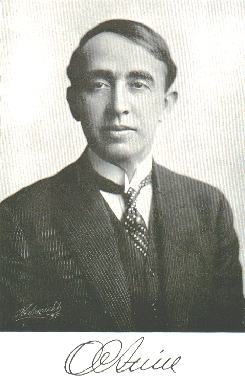
Oliver Charles STINE
Oliver
Charles STINE.† History teaches that the
men who best succeed in any line of business requiring the expenditure of
thought and the development of their intellect are those who have taken the rigidly-severe
training necessary for the entrance to one or other of the learned professions.† Especially is this true with reference to
the preparation requisite for admission to the bar.† Then, too, the knowledge thus gained can be put to practical use
in so many ways that the time spent in acquiring it is not lost even if a man
never practice his profession.† The late
Oliver Charles STINE found this to be essentially true in his case.† Graduated first from Evanston University,
Illinois, and later, in 1898, from the legal department of George Washington
University, Washington D.C. with the degree of Bachelor of Law, he was fully
qualified for the practice of law, but, instead, turned his attention to
business, and found his operations accelerated and his profits increased
because he knew the legal aspect of each transaction.† This was particularly true in his real estate operations.
Oliver
Charles STINE was born in Pennsylvania, October 30, 1877, and deciding upon a
legal career, prepared himself accordingly, as related above.† Following his graduation he came west to
California in the interests of the Century Dictionary, and after he reached the
Sacramento Valley became so impressed with the prospects of this region for extensive
real estate operations that he turned his attention to this line of work,
specializing upon the division of tracts of land into small farms.† His campaigns for the interesting of people
and the bringing into this section settlers of responsibility were
masterpieces, and he not only rendered a real service to these homes, but
assisted very materially in developing the Valley.† In this great development project he accomplished more than any
other one man, and it stands as an enduring monument to his memory.
In
1905, Mr. STINE married Isabel LONGDON, a daughter of Benjamin LONGDON, who for
many years was actively interested in sheep raising and agricultural pursuits
upon an extensive scale in California.†
He was born at Belleview, Illinois, in 1844.† His sympathies were with the North in the war between that
section and the South, and he enlisted in the Union Army, and served in it
during the greater part of the war.† In the
Ď70s he came to California, and was associated with Colonel HOLLISTER in the
sheep business.† Mr. and Mrs. STINE
became the parents of three children:†
John McLeod, Helen McLeod and Oliver Charles.† Mr. STINE belonged to the Bohemian Club and was one of itís
prominent members; also to the Family Club of San Francisco and the Civic Club
of Sacramento.† In the very prime of
useful manhood, when future accomplishments stretched out before him, and life
promised the most, Mr. STINE was called by death from his family and
friends.† His passing was regarded as a heavy
loss to his community, of which he had long been a useful citizen, to his
associates, to whom his helpful friendship had always been an inspiration, and
to his family, who were left desolate without his love and watchful care.
The
untimely death of Mr. STINE has prevented the completion of one of the most
beautiful and useful undertakings ever conceived for the upbuilding of San
Francisco.† He was the originator of the
plan whereby the district taken in by the Panama-Pacific Exposition should be developed
into the choicest residential district of the city.† The property lying as it did on the shores of the bay and being
protected by high bluffs from winds and inclement weather offered wonderful
natural advantages for such a plan, and Mr. STINE worked untiringly toward this
end.† A large number of different
interests had to be harmonized in the course of such an undertaking, and Mr.
STINE, enjoying as he did the unbounded confidence of these interests,
succeeded in bringing them together where probably any other man would have
failed.† The project called for the development
of the entire district from the Fine Arts Building south to the city docks. †Plans were prepared in such a manner that
every property owner would have splendid view of the harbor and the Marin and Alameda
County shores, as well as The Presidio and the Golden Gate.† A building restriction of $50,000 was placed
on all residences, and the entire project was well under way when Mr. STINEís
death stopped the whole proceeding, as it appeared that he was the only man
capable of carrying through the enterprise to a successful completion.† There is no doubt that the vast amount of
labor performed by him in this matter was a considerable contributing factor in
his demise, and San Francisco has lost the opportunity of having one of the
most beautiful, useful and artistic residential districts in the country.